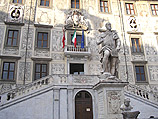|
|

PISA
During the powerful economic
and political centuries of the Marine Republic, art in Pisa
was particularly flourishing, above all, in the areas of sculpture
and architecture; marking in certain cases, the change from
Romanesque to the new Gothic forms, but still with characteristics
showing influences of various origins; from classical to oriental.
The Cathedral Square, known as the Square of Miracles, is
rightly renowned: on its ample and grassy areas (a 19th Century
choice), we can find the Cathedral (1063-12th Century), which
preserves the Pulpit by Giovanni Pisano (1302-10), the Bell
Tower (the famous leaning tower, 1173), the Baptistery (1152-14th
Century), containing decorative motifs on its exterior, already
orientated towards the Gothic style and which in its interior,
houses the Pulpit by Nicola Pisano (1260), the Camposanto
(Monumental Cemetery) (1278-83), heavily damaged by artillery
fire in 1944, but brought back to its original appearance
after long and detailed restoration to the present day, definitive
layout. The Square of Miracles, is a symbol of the power of
Pisa during the medieval era, both for its grandiose monuments
(the Cathedral has five naves), as well as for their artistic
qualities: the choice of marble, the refinement of the little
loggias, the attention to particulars, the search to create
harmony between one building and another, the works chosen
for their decorations, which represent in some way, an anthology
of Italian medieval sculpture.
A special note, awaits the Bell Tower of the Cathedral, well
known as the Tower of Pisa or Leaning Tower. It is cylindrical
in shape, and of Romanesque style, consisting of six loggia
arrangements, surmounted by a belfry cell. Initiated in 1173
by Bonanno Pisano, but interrupted half way through because
of its height, due to the incipient inclination; restarted
in 1275 by Giovanni di Simone, and terminated in 1372 by Tommaso
di Andrea di Pontedera, who still however, kept it lower in
respect to the original project. Work continued due to a slow
accentuation of its incline, necessitating a radical intervention
(1991), needed to stabilize its foundations; concluding successfully
in 2003 (from this moment on, thanks to modern technology,
the progressive inclination has been practically blocked,
or almost completely slowed down and the “state”
of the Tower is constantly monitored).
|
|
|
PISA
Art City
|
 FAMOUS
TOWER
FAMOUS
TOWER |
| |
 NORMALE SCHOOL
NORMALE SCHOOL |
| |
|
|
|
